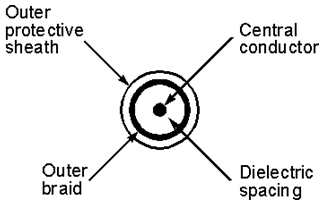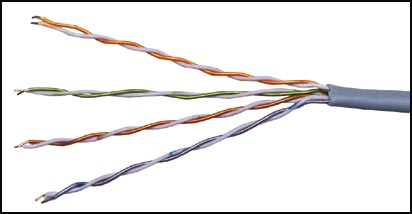Transmission Media
Guided Transmission Media
In Guided transmission media usually two kind of materials are used.
1. Copper
o Coaxial Cable
o Twisted Pair
2. Optical Fiber
1. Coaxial Cable: Coaxial cable made up of an inner conductor and an outer conductor and these are separated by an insulator. The inner conductor is typically copper. The outer conductor is enclosed by a plastic jacket. It is named coaxial because the two conductors are coaxial. Typical diameter of coaxial cable lies with in range of 0.4 inch to 1 inch. The main application of coaxial cable is cable T.V. The coaxial cable has large bandwidth, attenuation is low.

2. Twisted Pair: A Twisted pair made up of two insulated copper wires, normally 1mm thick. The wires are warped together in a helical form the purpose of twisting is to lower the cross talk interference between several pairs. Twisted Pair are more cheaper then coaxial cable but it is subject to noise and electromagnetic interference and attenuation is large.

Twisted Pair can be further classified in 2 categories:
Unshielded twisted pair: In this kind no insulation is provided, thus they are susceptible to interference.
Shielded twisted pair: In this a protective solid insulation is provided but shielded twisted pair are more expensive and not commonly used.
The most ordinary application of twisted pair is the telephone system. Nearly all telephones are linked to the telephone company office by a twisted pair. Twisted pair can work for several kilometres without amplification, but for big distances repeaters are needed. Twisted pairs cables can be used for both analog and digital transmission. The bandwidth depends on the width of wire and the distance travelled. Twisted pairs are usually limited in distance, bandwidth and rate of data.
3. Optical Fiber: In optical fiber light is used for sending data. In common terms occurrence of light is taken as bit 1 and its absence as bit 0. Optical fiber made up of inner core of either glass or plastic. Core is enclosed by cladding of the same material but its refractive index is different . This cladding is surrounded by a plastic jacket which prevents optical fiber from electromagnetic interference and severely environments. It uses the principle of total internal reflection to transfer data over optical fibers. These are much better in bandwidth as compared to copper wire, since there is barely any attenuation or electromagnetic interference in optical wires. Hence there are fewer resources to improve quality of signal, in long distance transmission. Main disadvantage of optical fiber is that end points are fairly expensive. (for example:- switches)
Differences between various kinds of optical fibers:
1. Depending on material
§ Made of glass
§ Made of plastic.
2. Depending on radius
§ Thin optical fiber
§ Thick optical fiber
3. Depending on light source
§ LED (for low bandwidth)
§ Injection lased diode (for high bandwidth)
Email based Computer Science assignment help - homework help at Expertsmind
Are you searching Computer Science expert for help with Transmission Media questions? Transmission Media topic is not easier to learn without external help? We at www.expertsmind.com offer finest service of Computer Science assignment help and computer science homework help. Live tutors are available for 24x7 hours helping students in their Transmission Media related problems. We provide step by step Transmission Media question's answers with 100% plagiarism free content. We prepare quality content and notes for Transmission Media topic under computer science theory and study material. These are avail for subscribed users and they can get advantages anytime.
Why Expertsmind for assignment help
- Higher degree holder and experienced experts network
- Punctuality and responsibility of work
- Quality solution with 100% plagiarism free answers
- Time on Delivery
- Privacy of information and details
- Excellence in solving computer science questions in excels and word format.
- Best tutoring assistance 24x7 hours